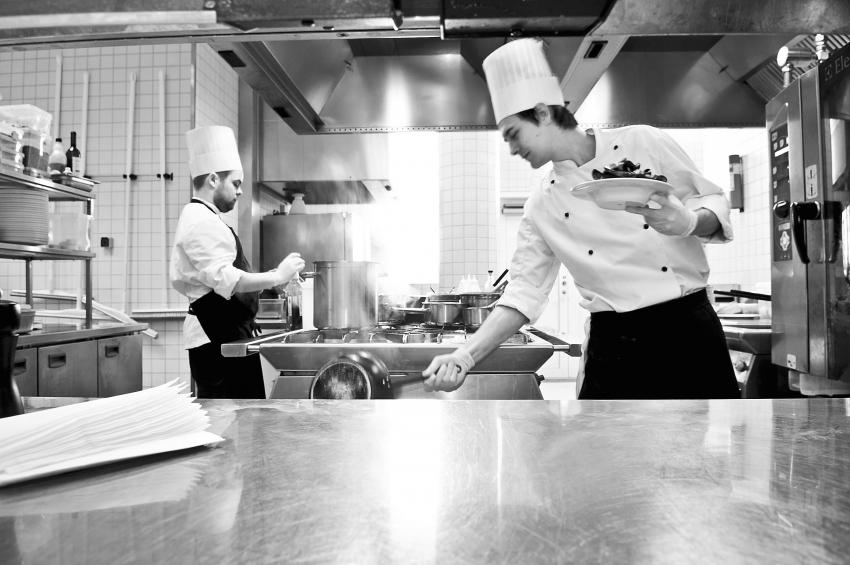Ice Machines, Beverage Dispensers & Other Overlooked Food Safety Hazards
At the end of the spring semester in our campus food production lab, we’re fortunate to have the opportunity to hit pause and reset for the summer and prepare for fall—a luxury many foodservice operations don’t often get. During this time, we can deep clean, shut down equipment, and perform a thorough reset of the space. While some school foodservice programs may also have this seasonal window, many commercial kitchens operate year-round and rarely have the chance to step back in this way.
Among the many pieces of equipment that we focus on cleaning during this time are the ice machine and soda dispensers. We clean them throughout the year, too, but they are pieces of equipment that are sometimes neglected. I can see why some may forget about them. In food safety training, much attention is paid to keeping food at safe temperatures, avoiding cross-contamination, and ensuring hand hygiene. While the spotlight is often on cooking and holding procedures, some food safety hazards are hiding in plain sight: ice machines, beverage dispensers, and other equipment that’s easy to forget during daily cleaning routines.
Ice is considered a food under FDA guidelines, which means it must be handled and stored with the same care as any other consumable. Yet, ice machines are notorious for harboring mold, slime, and bacteria, often due to irregular cleaning and maintenance. Ice scoops left on top of the machine, hands reaching into bins, or contaminated utensils can all introduce pathogens. When was the last time you inspected the water line to your ice machine – or even more importantly, the filter? Just as with any surface, if they are not cleaned and sanitized regularly, the risk of contamination only grows.
In foodservice operations, ice is an important component of the service and production processes. It is used for both beverages and for cooling of food. Thus, it is important to be diligent in cleaning and monitoring ice machines.
…Food safety isn’t just keeping hot foods hot and cold foods cold; it’s about the unseen risks that accumulate over time.
Soda fountains and beverage dispensers can also be a hidden hazard. Sugary syrups and low-acid liquids provide a perfect breeding ground for bacteria and yeast, especially in and around the nozzles and drip trays. These areas often go unnoticed in daily cleaning routines and can develop biofilms—thin layers of microbial growth that are hard to remove and can contaminate drinks. In most cases, the trays themselves are dark in color, often black, meaning spotting these biofilms is not easy to do visually.
Another issue arises with the internal tubing of beverage systems. Without proper flushing and sanitization, residue can build up, leading to off-flavors and microbial risks. In both commercial and institutional settings, ensuring that staff are trained to clean these systems according to the manufacturer’s specifications is essential.
Beyond ice and beverages, there are many overlooked surfaces that require consistent attention. Refrigerator gaskets can collect food particles and condensation, creating a moist, dark environment where mold and bacteria thrive. Handles of reach-in coolers, microwave buttons, and faucet levers are frequently touched but seldom cleaned with the same rigor as food prep surfaces.
Food safety isn’t just keeping hot foods hot and cold foods cold; it’s about the unseen risks that accumulate over time. By creating comprehensive cleaning schedules that include non-obvious equipment and surfaces, and by regularly training staff on the “why” behind those practices, foodservice operations can protect both their customers and their reputations. After all, preventing illness doesn’t just happen on the line—it happens behind the ice machine, under the soda fountain, and everywhere in between. Risk Nothing.
READ MORE POSTS
Top Food Safety Websites
You ask…How do I learn about food safety regulation? What pathogens in foods can make me sick? What temperature should I safely cook my roast beef to and how do I take food temperatures? How do I clean and sanitize anything according to the FDA Food Code? What and where is the most recent version of the FDA Food Code? Where can I find food safety educational materials galore in book form or online? Do I need them in Spanish or a Chinese dialect?
A Little Poultry Safety Information
Chicken is the number one species of protein consumed by Americans – we eat about 80 pounds of it per year. Outbreaks of foodborne illness have long been associated with poultry and eggs usually by undercooking it or cross-contamination of other foods by raw poultry. Recent concerns about avian or bird flu put the direct focus on our fowl food with concerns about whether this awful disease can transfer from birds to humans.
The Basic Principles of Food Safety
Every food establishment uses, processes, and sells food in different ways. However, the general issues and key principles of food safety remain the same, whatever the style of the operation. All food safety training programs should contain the “big 3” factors that could cause food to become unsafe. Food must be kept out of harms way from human errors, but if you don’t train food workers what they are, they won’t know why these factors are so important to your operation. The basics can make us or break us in one or maybe two food handling mistakes.









